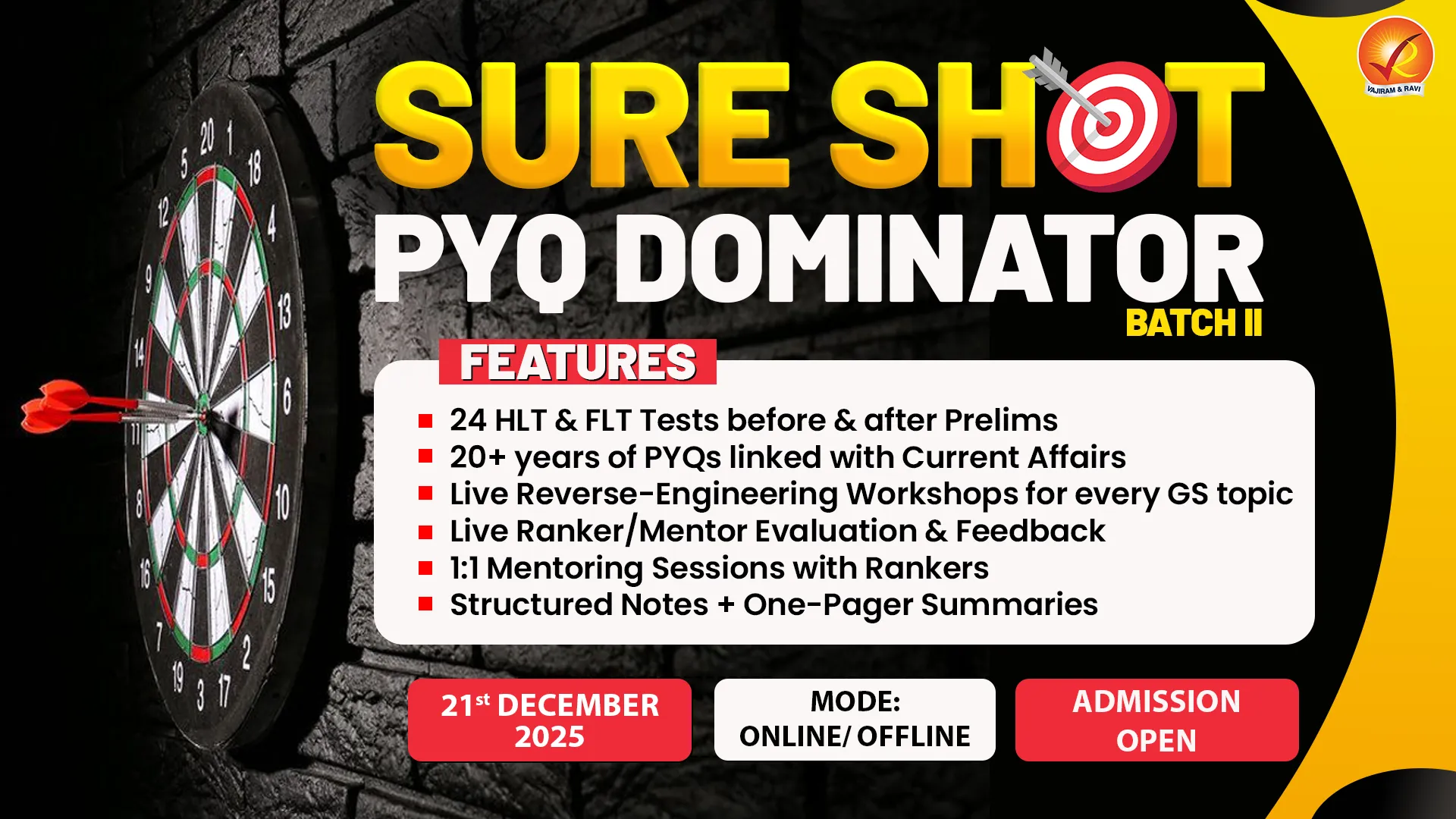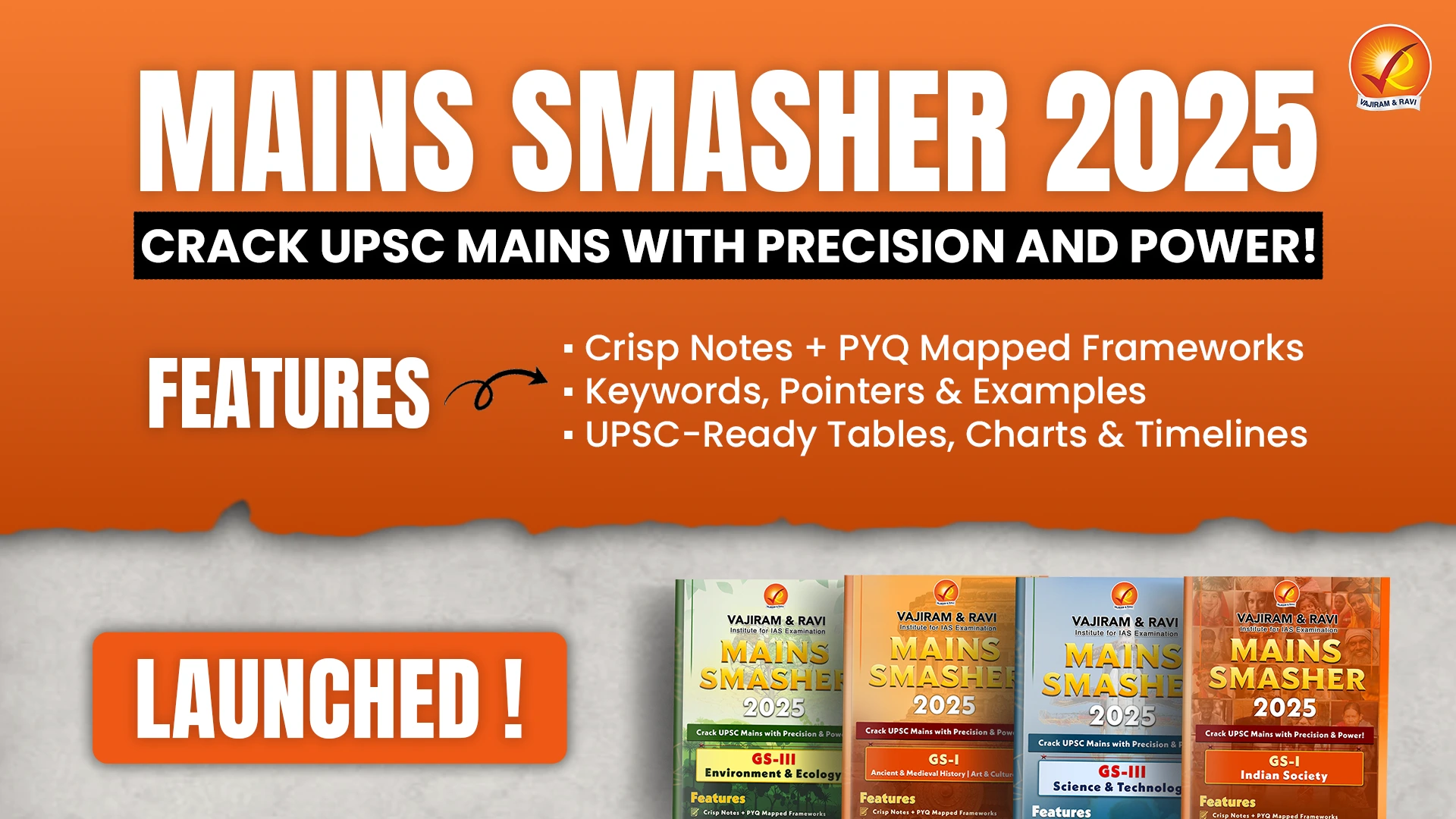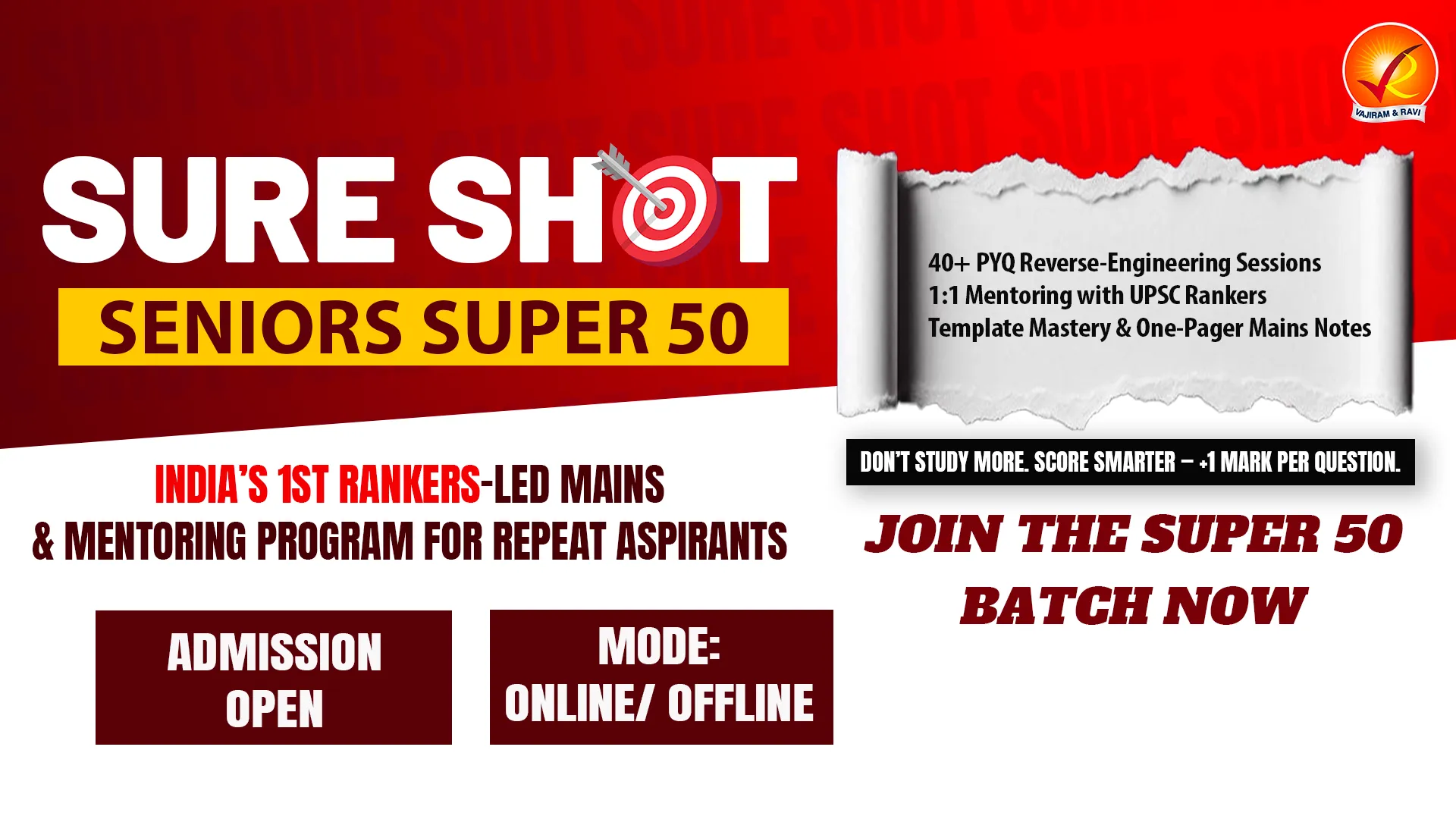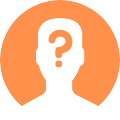Upcoming Mentoring Sessions
Learning Support Session - ANSWER writing MASTER Session
Learning Support Session - How to Read Newspaper?
Mastering Art of writing Ethics Answers
Mastering Art of Writing Social Issues Answers
Answer Review Session
RMS - Economy 11 - Infrastructure
RMS - Art & Culture 3
RMS - Polity 7 - Parliament 3
RMS - Geography - Indian Physiography - 2
RMS - Economy 10 - Agriculture
RMS - Polity 7 - Parliament 2
RMS - Geography - Indian Physiography
RMS - Polity 7 - Parliament 1
RMS -Economy 9 - Fundamentals of Indian Economy
RMS - Geography 5 - Major Landforms
RMS - Art & Culture 2
RMS - Geography 4 - Volcanoes, Volcanic Landforms and Rocks
RMS - Polity 6 - Judiciary 2
RMS - Economy 8 - Trade and Important Government Schemes
RMS - Geography 3 - Evolution of Oceans and Continents
RMS - Economy 7 - Inflation
RMS - Polity 6 - Judiciary 1
RMS - Geography 2 - Basic Concepts of Universe & Earth Interior
RMS - Art & Culture 1
RMS - Economy 6 - Balance of Payment
RMS - Geography 1 - Geomorphic Processes
RMS - Polity 5 - Constitutional & Non-Constitutional Bodies
Mentoring Session - UPSC Form Filling
RMS - Economy 5 - Financial Markets
RMS - Polity 4 - Fundamental Rights - P3
RMS - Economy 4 - Fiscal Policy and Budgeting
RMS - History 2 - From 1765 to 1858 - P2
RMS - Polity 4 - Fundamental Rights - P2
RMS - Economy 3 - Taxation
RMS - Polity 4 - Fundamental Rights-P1
RMS - History 1 - European Penetration to Battle of Buxar
RMS - Economy 2 - Money & Banking - P2
Mentoring Session (2024 - 25) - How to Write an ESSAY?
Social Issues Doubts and Mentoring Session
Ethics & Essay Doubts and Mentoring Session
Geography & Environment Doubts and Mentoring Session
History Doubts and Mentoring Session
Economy & Agriculture Doubts and Mentoring Session
Online Orientation Session
How to Read Newspaper and Make Notes?
Mains Support Programme 2025-(2)
Mains Support Programme 2025- (1)
Polity & International Relations Doubts and Mentoring Session
Mentoring Sessions (2024-25) - How to DO REVISION?
RMS - Polity - Parliament 3
Learning Support Session - How to Start Preparation?
RMS - Geography - World Mapping
RMS - Polity - Parliament 2
Prelims 2024 Strategy Session
RMS - Polity 3 - Union & its Territories and Citizenship
RMS - Geography - Major Landforms
RMS - Polity 2 - Preamble
RMS - Economy 2 - Money & Banking - P1
Mentoring Session (2024-25) - How to Make Notes?
RMS - Polity 1 - Constitution & its Salient Features
General Mentoring Session (GMS )
RMS - Modern History - Constitutional Developments - Important Acts in British India
Mentoring Session (2025-26) - How to write an Answer?
RMS - Economy 1 - Fundamentals of Economy and NIA
Current Affairs
Dec. 26, 2025
Himalayan Red Fox
A brief roadside encounter with a Himalayan red fox near Pangong Tso in Ladakh has captivated social media users recently, but the viral clip has also prompted a cautionary note from wildlife officials about the hidden risks of human interference.

About Himalayan Red Fox:
- The Himalayan Red Fox, a subspecies of the widespread red fox (Vulpes vulpes), is one of the most adaptable predators of the high-altitude landscapes.
- Scientific Name: Vulpes vulpes montana
- Distribution:
- It is native to the Himalayan mountain range in India, Nepal, Bhutan, and Tibet.
- It has a wide distribution in the Indian Himalayan region, including the states of Jammu and Kashmir, Himachal Pradesh, Uttarakhand, Sikkim, and Arunachal Pradesh.
- Habitat:
- They are known to occupy a variety of habitats, including alpine meadows, grasslands, forests, and agricultural lands.
- Features:
- It is a medium-sized mammal, with males being slightly larger and heavier than females.
- The coat of the Himalayan red fox is typically rusty-red in color, with white underparts and a distinctive white-tipped tail.
- It is a solitary and nocturnal
- Conservation Status:
- IUCN Red List: Least Concern
Key Facts about Pangong Tso:
- Pangong Tso, or Pangong Lake, is a long, narrow, endorheic (landlocked) lake in the Ladakh Himalayas.
- It is the world’s highest saltwater lake.
- It is also known to change colors, appearing blue, green, and red at different times.
Environment
Current Affairs
Dec. 26, 2025
Key Facts about Vitamin C
Recent research suggests that large doses of vitamin C may provide the lungs with a degree of protection from the harmful effects of fine particles in the air.

About Vitamin C:
- Vitamin C, also known as ascorbic acid, is a water-soluble vitamin.
- Function:
- It is needed for the growth and repair of tissues in all parts of body. It is used to:
- Form an important protein called collagen, used to make skin, tendons, ligaments, and blood vessels.
- Heal wounds and form scar tissue.
- Repair and maintain cartilage, bones, and teeth.
- Aid in the absorption of iron.
- It is a powerful antioxidant that can neutralize harmful free radicals.
- It helps make several hormones and chemical messengers used in the brain and nerves.
- It is needed for the growth and repair of tissues in all parts of body. It is used to:
- The body doesn't make vitamin C. It comes from the diet.
- Sources:
- Vitamin C comes from fruits and vegetables.
- Good sources include citrus, red and green peppers, tomatoes, broccoli, and greens.
- Some juices and cereals have added vitamin C.
- Vitamin C is sensitive to heat, so some of its nutritional benefits can be lost during cooking. Raw foods are more beneficial as dietary sources.
- Vitamin C is not stored in body, so deficiency can happen quickly.
- Sometimes, vitamin C deficiency can lead to scurvy.
- Scurvy symptoms and signs can include anemia, exhaustion, spontaneous bleeding, limb pain, swelling, and sometimes ulceration of the gums and loss of teeth.
Science & Tech
Current Affairs
Dec. 26, 2025
Key Facts about Titan
Saturn's largest moon, Titan, may not have a subsurface ocean after all, according to a re-examination of data captured by NASA's Cassini spacecraft, which flew by Titan dozens of times starting in 2004.

About Titan:
- Titan is Saturn's largest moon.
- It is the second largest moon in our solar system after Jupiter's moon Ganymede.
- It is the only moon in the solar system with a dense atmosphere.
- It's the only world besides Earth that has standing bodies of liquid, including rivers, lakes, and seas, on its surface.
- Like Earth, Titan’s atmosphere is primarily nitrogen, plus a small amount of methane.
- Titan takes 15 days and 22 hours to complete a full orbit of Saturn.
- Titan is also tidally locked in synchronous rotation with Saturn, meaning that, like Earth’s Moon, Titan always shows the same face to the planet as it orbits.
Key Facts about Cassini Spacecraft:
- It is a joint project of NASA, the European Space Agency, and the Italian Space Agency (ASI).
- Cassini was a sophisticated robotic spacecraft sent to study Saturn and its complex system of rings and moons in unprecedented detail.
- It was launched in 1997. It was one of the largest interplanetary spacecraft.
- The mission consisted of NASA’s Cassini orbiter, which was the first space probe to orbit Saturn, and the ESA’s Huygens probe, which landed on Titan, Saturn’s largest moon.
Science & Tech
Current Affairs
Dec. 26, 2025
Rashtriya Prerna Sthal
The Prime Minister recently inaugurated the Rashtra Prerna Sthal in Lucknow, Uttar Pradesh, dedicated to the life and ideals of former Prime Minister Atal Bihari Vajpayee, marking his 101st birth anniversary.

About Rashtriya Prerna Sthal:
- It has been developed as a landmark national memorial and inspirational complex of enduring national significance.
- It has been dedicated to the life and ideals of former Prime Minister Shri Atal Bihari Vajpayee.
- It is located on the banks of the Gomti River in Lucknow, Uttar Pradesh.
- The complex also features 65-foot-high bronze statues of Syama Prasad Mookerjee and Pandit Deendayal Upadhyaya, alongside the former Prime Minister of India Atal Bihari Vajpayee.
- The complex is envisioned as a permanent national asset dedicated to fostering leadership values, national service, cultural consciousness, and public inspiration.
- The complex houses a state-of-the-art museum designed in the shape of a lotus flower.
Polity & Governance
Current Affairs
Dec. 26, 2025
Quality Council of India (QCI)
The Quality Council of India (QCI) recently announced a comprehensive set of next-generation quality reforms aimed at strengthening India’s quality ecosystem across healthcare, laboratories, MSMEs, and manufacturing sectors.

About Quality Council of India (QCI):
- It is a non-profit autonomous organisation registered under Societies Registration Act XXI of 1860.
- It was set up in 1997 jointly by the Government of India and the Indian Industry, represented by the three premier industry associations, i.e.,
- Associated Chambers of Commerce and Industry of India (ASSOCHAM)
- Confederation of Indian Industry (CII)
- Federation of Indian Chambers of Commerce and Industry (FICCI).
- It is under the administrative control of the Department for Promotion of Industry and Internal Trade (DPIIT), Ministry of Commerce and Industry.
- Functions:
- It works as the national accreditation body.
- It has been established to create a mechanism for independent third-party assessment of products, services, and processes.
- It also promotes the adoption of quality standards relating to Quality Management Systems, Food Safety Management Systems, and Product Certification and Inspection Bodies through the accreditation services provided by the National Accreditation Board for Certification Bodies (NABCB).
- It plays a pivotal role at the national level in propagating, adoption, and adherence to quality standards in all important spheres of activities.
- It leads a nationwide quality movement in the country through the National Quality Campaign.
- Boards/divisions under QCI:
- National Accreditation Board for Testing & Calibration Laboratories (NABL)
- National Accreditation Board for Hospitals & Healthcare Providers (NABH)
- National Accreditation Board for Education & Training (NABET)
- National Accreditation Board for Certification Bodies (NABCB)
- National Board for Quality Promotion (NBQP).
- Every board is functionally independent and works within its area of expertise.
- The council comprises 38 members, with equal representation from the government, industries, and other stakeholders.
Polity & Governance
Current Affairs
Dec. 26, 2025
Minamitori Island
Japan will conduct test mining of rare-earth-rich mud from the deep seabed off Minamitori Island

About Minamitori Island:
- It also known as Marcus Island is an isolated Japanese coral atoll in the northwestern Pacific Ocean.
- It is at the easternmost edge of Japan, the island is the first in Japan to see the sun rise.
- Topography and Formation of Minamitori Island:
- It is the summit of a giant seamount rising from the seafloor located on the Marcus-Necker Ridge, and the only land of it in Japan on the Pacific Plate.
- Climate: It is in the transitional zone between tropical and subtropical climates, has an oceanic climate with an average annual temperature of around 25.6°C.
- Resources: Valuable marine mineral resources like rare-earth muds and cobalt-rich crust have been discovered in the waters surrounding the Minamitorishima Island.
What is Rare-earth mud?
- Rare-earth muds are pelagic muds made by accumulated remains of plankton in which a large amount of rare-earth is contained.
- It contains significant amounts of minerals such as neodymium and dysprosium, which are used in high-performance magnets for motors and power generators.
- It is distributed across the ocean floor as a thin layer and cannot be excavated deeply like coal.
Geography
Current Affairs
Dec. 26, 2025
Valmiki Tiger Reserve
The tiger population in the Valmiki Tiger Reserve in West Champaran district has increased more than sevenfold over a 15-year period, rising from eight in 2010 to 54 in the last census conducted in 2022.

About Valmiki Tiger Reserve:
- Location: It is located at the India-Nepal border in the northern part of the West Champaran District of
- It forms the easternmost limit of the Himalayan Terai forests in India and is the only tiger reserve of Bihar.
- It comprises the Valmiki National Park and the Valmiki Wild Sanctuary.
- It is situated in the Gangetic Plains bio-geographic zone of the country, the forest has a combination of Bhabar and Terai tracts.
- Bordered by: It is surrounded by the Royal Chitwan National Park of Nepal in the north and the river Gandak on the western side, with the Himalayan mountains as a backdrop.
- Drainage: The rivers Gandak, Pandai, Manor, Harha, Masan, and Bhapsa flow through various parts of the reserve.
- Vegetation: The reserve boasts a variety of vegetation types, including tropical wet deciduous forests, grasslands, savannas, and riverine forests.
- Flora: Sal trees dominate the forests, but the region also features species like teak, bamboo, semal, and khair.
- Fauna: Tiger, leopard, fishing cat, leopard cat, sambar, hog deer, spotted deer, black buck, gaur, sloth bear, langur, rhesus monkey, etc.
Environment






































